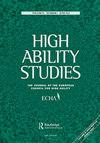Can judo experience, somatic maturation, growth and physical capacities discriminate young judo athletes from different competitive levels?
IF 1.8
4区 教育学
Q2 EDUCATION, SPECIAL
引用次数: 6
Abstract
ABSTRACT This study aimed to analyze whether judo experience, somatic maturation, growth, and physical capacities discriminate young judo athletes from different competitive levels (state and national). Sixty-six young male judo athletes (36 from state and 30 from national level) participated in this study, divided from the annual competitive season. The assessments were performed in two stages separated by 48 hours: anthropometric measurements and physical tests (standing long jump – SLJ, medicine ball throw test-MBT, handgrip strength test – HGS, Special Judo Fitness Test – SJFT and Judogi Grip Isometric Strength Test–JGST). Judo athletes were asked for their date of birth and judo experience. T-test and discriminant analysis were used to compare and discriminate the variables between young judo athletes from state and national groups with the level of significance set at 5%. The main results showed that stature, judo experience, JGST, and SLJ performance were higher in the national group (p < 0.05) and could adequately discriminate competitive levels (structural coefficient >30, p < 0.001). It was concluded that young male judo athletes who compete at the national level are taller, more experienced, and present superior physical performance in tests related to strength and power than athletes from the state group of the same age.柔道经验、身体成熟度、成长和体能是否能区分不同竞技水平的年轻柔道运动员?
摘要本研究旨在分析柔道经验、身体成熟、成长和体能是否能区分不同竞技水平(州和国家)的年轻柔道运动员。66名年轻男子柔道运动员(36名来自州,30名来自国家级)参加了这项研究,分为年度比赛季。评估分为两个阶段进行,间隔48小时:人体测量和身体测试(站立跳远-SLJ、药球投掷测试MBT、握力测试-HGS、特殊柔道体能测试-SJFT和柔道握力等距力量测试-JGST)。柔道运动员被问及他们的出生日期和柔道经验。采用T检验和判别分析对州和国家组青年柔道运动员的变量进行比较和判别,显著性水平设定为5%。主要结果表明,国家组的身材、柔道经验、JGST和SLJ成绩较高(p<0.05),能够充分区分竞技水平(结构系数>30,p<0.001),并且在与力量和力量相关的测试中表现出比同龄国家组运动员更好的身体表现。
本文章由计算机程序翻译,如有差异,请以英文原文为准。
求助全文
约1分钟内获得全文
求助全文
来源期刊

High Ability Studies
Multiple-
CiteScore
4.80
自引率
11.10%
发文量
7
期刊介绍:
High Ability Studies provides a forum for scholars in a variety of disciplines associated with the development of human abilities to their highest level. It is a medium for the promotion of high ability, whether through the communication of scientific research, theory, or the exchange of practical experience and ideas. The contents of this journal are unique in reflecting concerns and recent developments in this area from childhood and across the whole life span in a variety of contexts. Far from being restricted to the traditional focus on high-level cognitive development, it also presents investigations into all other areas of human endeavour, including sport, technology, the arts, business, management and social relations.
 求助内容:
求助内容: 应助结果提醒方式:
应助结果提醒方式:


